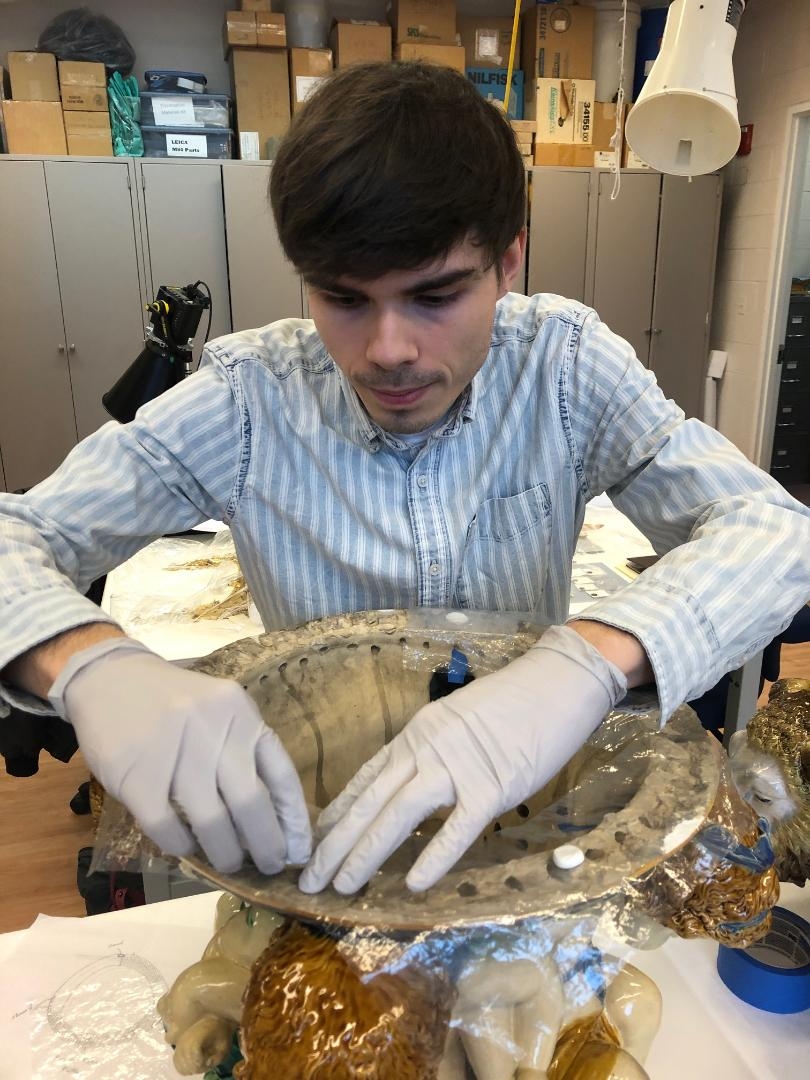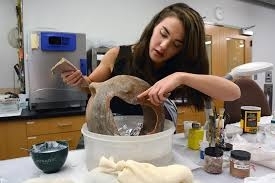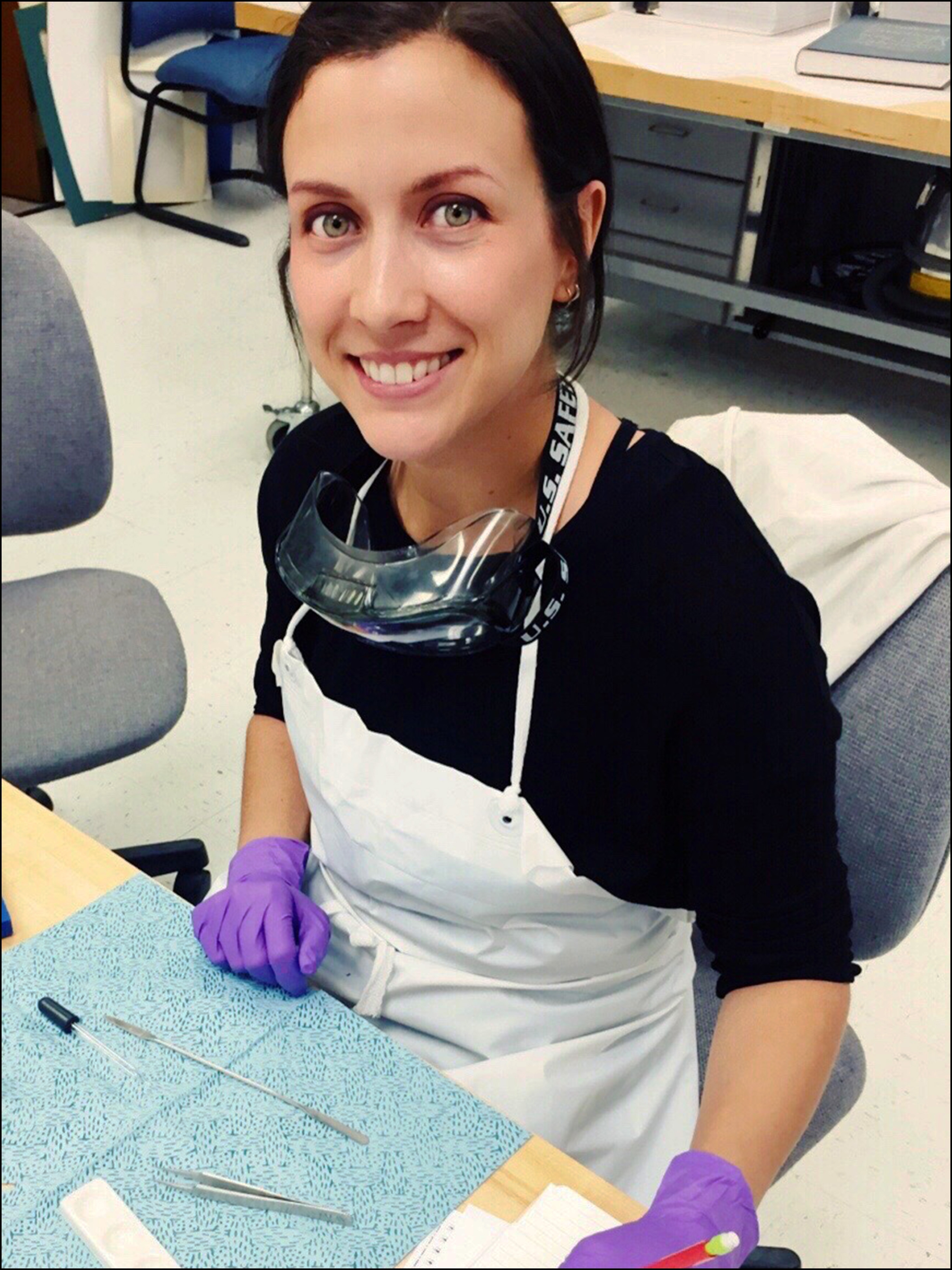Conservation Graduate Students Meet Challenges of Interrupted Internships
The 2020 graduates of the UCLA/Getty Program in the Conservation of Archaeological and Ethnographic Materials face an unexpected challenge in their final year of the program. They were anticipating the continuation of their hard-won, hands-on third-year internships at museums around the country. But because of the closures of their respective institutions since mid-March, due to the Covid-19 pandemic, their hands have been on computer keyboards rather than unique cultural heritage objects.
 For Austin Anderson, his internship at the Walters Art Museum in Baltimore began in September 2019. The museum has one of the oldest conservation departments in the country and a long-standing tradition of teaching and mentoring interns, Anderson explained. He had hoped to explore his interest in medieval art and objects, but became involved in preparing pieces for an impending show. Just when he was about to start on his intended project, the museum was closed. From his apartment in Baltimore, he is trying to complete some of the treatment reports he was working on before the closure. Although he thinks he will be unable to complete them before the internship is over in June, he is doing very detailed documentation for whomever continues with the work. He is also working on a small research project for the museum on conservation materials; research in a more comprehensive way that he would not have been doing otherwise. He says he will finish his research projects, include as much detail as possible in his treatment reports, and continue attending remote weekly meetings. Whereas some of his fellow graduates took two internships during the nine-month third-year placement, Anderson stayed at one institution. “I got twice as much experience and a little more time to settle in,” he said, but he missed the diversity that might have come with two internships. Fortunately, he has just accepted a two-year fellowship at the Glenstone Museum, also in Maryland, starting in September. A native Californian, Anderson says that the only downside is the summer on the East Coast. But that is a sacrifice he is more than willing to make.
For Austin Anderson, his internship at the Walters Art Museum in Baltimore began in September 2019. The museum has one of the oldest conservation departments in the country and a long-standing tradition of teaching and mentoring interns, Anderson explained. He had hoped to explore his interest in medieval art and objects, but became involved in preparing pieces for an impending show. Just when he was about to start on his intended project, the museum was closed. From his apartment in Baltimore, he is trying to complete some of the treatment reports he was working on before the closure. Although he thinks he will be unable to complete them before the internship is over in June, he is doing very detailed documentation for whomever continues with the work. He is also working on a small research project for the museum on conservation materials; research in a more comprehensive way that he would not have been doing otherwise. He says he will finish his research projects, include as much detail as possible in his treatment reports, and continue attending remote weekly meetings. Whereas some of his fellow graduates took two internships during the nine-month third-year placement, Anderson stayed at one institution. “I got twice as much experience and a little more time to settle in,” he said, but he missed the diversity that might have come with two internships. Fortunately, he has just accepted a two-year fellowship at the Glenstone Museum, also in Maryland, starting in September. A native Californian, Anderson says that the only downside is the summer on the East Coast. But that is a sacrifice he is more than willing to make.
 Elena Bowen spent the first part of her third-year internship at the Hirshhorn Museum in Washington, D.C. Starting in February, she joined the Carlos Museum at Emory University in Atlanta. “It is really a great museum in a beautiful building with a collection that is mostly archaeological and ethnographic,” Bowen explained. She was able to work with the collection only for a few weeks before the campus was closed. One of the main projects that she is now working on from her home in Miami is creating lesson plans for an outreach project in collaboration with a local elementary school. The lesson plans are based on the collection of the museum, with one per grade from kindergarten through fifth grade. They are working with the science-technology-engineering-mathematics teacher so that she can actually implement the plans in the classroom and introduce these young people virtually to what is in the museum. She has been asked to work with the museum on this program through August. Although this was not the original plan, she said it resulted from a collaborative effort among the four people in the laboratory at the Carlos Museum when they found out the museum was closing. “We got together and talked about what projects we had going on that could be done from home and came up with this one.”
Elena Bowen spent the first part of her third-year internship at the Hirshhorn Museum in Washington, D.C. Starting in February, she joined the Carlos Museum at Emory University in Atlanta. “It is really a great museum in a beautiful building with a collection that is mostly archaeological and ethnographic,” Bowen explained. She was able to work with the collection only for a few weeks before the campus was closed. One of the main projects that she is now working on from her home in Miami is creating lesson plans for an outreach project in collaboration with a local elementary school. The lesson plans are based on the collection of the museum, with one per grade from kindergarten through fifth grade. They are working with the science-technology-engineering-mathematics teacher so that she can actually implement the plans in the classroom and introduce these young people virtually to what is in the museum. She has been asked to work with the museum on this program through August. Although this was not the original plan, she said it resulted from a collaborative effort among the four people in the laboratory at the Carlos Museum when they found out the museum was closing. “We got together and talked about what projects we had going on that could be done from home and came up with this one.”
 Kasey Hamilton wanted to broaden her experience base and do her third-year internship somewhere that housed an encyclopedic collection ranging from ancient to modern. So she chose the Nelson Atkins Museum in Kansas City, where she added to her archaeological and ethnographic materials background by working with decorative arts and modern and contemporary art. She was involved in a large, contemporary installation piece when the museum shuttered because of the Covid-19 pandemic, but also had the opportunity to work on an ancient Egyptian mummy portrait and eighteenth century English ceramics. She was in the phase of recording treatments and writing up everything that she had done, as well as researching whether or not some components of the installation could be remade by a fabricator. Although she will not be the actual conservator now, she wants to make sure that there is a clear outline of what she had planned to do so that the institution could continue with the project. This included documenting all the correspondence that she had with outside fabricators. From her home in Los Angeles, she continues to attend and contribute to meetings of the conservation department of the museum, where there are updates from the head of the Objects Laboratory and many discussions about the status of projects, exhibitions, and even hiring.
Kasey Hamilton wanted to broaden her experience base and do her third-year internship somewhere that housed an encyclopedic collection ranging from ancient to modern. So she chose the Nelson Atkins Museum in Kansas City, where she added to her archaeological and ethnographic materials background by working with decorative arts and modern and contemporary art. She was involved in a large, contemporary installation piece when the museum shuttered because of the Covid-19 pandemic, but also had the opportunity to work on an ancient Egyptian mummy portrait and eighteenth century English ceramics. She was in the phase of recording treatments and writing up everything that she had done, as well as researching whether or not some components of the installation could be remade by a fabricator. Although she will not be the actual conservator now, she wants to make sure that there is a clear outline of what she had planned to do so that the institution could continue with the project. This included documenting all the correspondence that she had with outside fabricators. From her home in Los Angeles, she continues to attend and contribute to meetings of the conservation department of the museum, where there are updates from the head of the Objects Laboratory and many discussions about the status of projects, exhibitions, and even hiring.
 Skyler Jenkins had the good fortune of spending September through December of 2019 in an internship at the Benaki Museum in Athens, Greece. She was able to work on more modern objects than is usual for her and which she found offered both a change and a challenge. She is currently in Philadelphia, where she started at the University of Pennsylvania Museum of Archaeology and Anthropology in late January, working on two major treatment projects: one of a Mesoamerican ceramic vessel and the other of a copper-alloy Egyptian door hinge. It was very exciting work, she said, having almost completed the pre-treatment work on the ceramic vessel and just starting treating the hinge, when the museum closed. Everyone assumed that they would be back at work in a few weeks. But Philadelphia has extended its stay-at-home order until June 5, and Jenkins’ internship is only through the end of June. Although she is very disappointed that she will not continue her work at the museum, her supervisor told her to finish her thesis. She is glad to have the extra time to deepen her research on a novel treatment for fragile bone that is excavated and cannot be removed from the ground without disintegrating and needs to be preserved for study by other specialists.
Skyler Jenkins had the good fortune of spending September through December of 2019 in an internship at the Benaki Museum in Athens, Greece. She was able to work on more modern objects than is usual for her and which she found offered both a change and a challenge. She is currently in Philadelphia, where she started at the University of Pennsylvania Museum of Archaeology and Anthropology in late January, working on two major treatment projects: one of a Mesoamerican ceramic vessel and the other of a copper-alloy Egyptian door hinge. It was very exciting work, she said, having almost completed the pre-treatment work on the ceramic vessel and just starting treating the hinge, when the museum closed. Everyone assumed that they would be back at work in a few weeks. But Philadelphia has extended its stay-at-home order until June 5, and Jenkins’ internship is only through the end of June. Although she is very disappointed that she will not continue her work at the museum, her supervisor told her to finish her thesis. She is glad to have the extra time to deepen her research on a novel treatment for fragile bone that is excavated and cannot be removed from the ground without disintegrating and needs to be preserved for study by other specialists.
Megan Salas has been actively using her unexpected time at home creatively to further her research and stay in touch with the staff at the Museum of Fine Arts in Houston, where she began her second third-year internship at the beginning of the year. Once it became apparent that the museum was not going to open anytime soon, she decided to drive back to Los Angeles and take advantage of the ability to work from home. She continues to participate in museum staff meetings, but is concentrating on treatment reports and getting her documentation in order. The documentation, she pointed out, “is an important part of what we do.  But it often gets pushed aside until it is absolutely necessary because we are focused on getting objects ready to be on view. So one nice thing is that I feel that I have an opportunity to get the documentation completed as best as possible.” She is also reaching out to conservators at other institutions with a specific question about a work that is going to be installed in Houston in the fall. Before the museum closure due to the Covid-19 pandemic, she had been working on some decorative art ceramics that needed loss compensation, and she was almost done with them. She hopes to go back to Houston during the summer to complete those projects. She was pleased that she had earlier completed treatment on a couple of objects for a show on Italian radical design, which she really enjoyed working on. “Those were things I got to finish, so that’s good. They are currently on view, but no one is there to see them, at least right now.”
But it often gets pushed aside until it is absolutely necessary because we are focused on getting objects ready to be on view. So one nice thing is that I feel that I have an opportunity to get the documentation completed as best as possible.” She is also reaching out to conservators at other institutions with a specific question about a work that is going to be installed in Houston in the fall. Before the museum closure due to the Covid-19 pandemic, she had been working on some decorative art ceramics that needed loss compensation, and she was almost done with them. She hopes to go back to Houston during the summer to complete those projects. She was pleased that she had earlier completed treatment on a couple of objects for a show on Italian radical design, which she really enjoyed working on. “Those were things I got to finish, so that’s good. They are currently on view, but no one is there to see them, at least right now.”
“The UCLA/Getty Conservation class of 2020 is a special cohort,” offered Glenn Wharton, chair of the Interdepartmental Program in the Conservation of Archaeological and Ethnographic Materials. “They bonded from the start and remained close through the trying times of the Covid-19 pandemic. Their resilience and resourcefulness come through in these touching stories about how they adapted their internships. None of us really know what the world will look like as we re-enter society, but we can imagine that life will never be quite the same. The strong sense of community and ability to adapt will serve them well. We depend on them to bring the values of their generation to the conservation of cultural heritage. Their commitment to sustainability and social justice will enrich how we care for objects we preserve and narratives that we construct about the past.”
A special Zoom Graduation featuring student presentations and a virtual reception will be held June 11–12, 2020 to honor the UCLA/Conservation Program Class of 2020. Registration is required. Please contact William Shelley at wshelley@ucla.edu for additional details.

The UCLA/Getty Conservation Class of 2020: Emily Rezes, Elena Bowen, Austin Anderson, Skyler Jenkins, Kasey Hamilton, and Megan Salas.
The Interdepartmental Program in the Conservation of Archaeological and Ethnographic Materials, administered through the Cotsen Institute, grants two degree programs focusing on cultural heritage preservation. One is a three-year M.A. degree in Conservation, which is a collaborative effort between UCLA and the Getty Conservation Institute. The other program is a PhD in the Conservation of Material Culture. The mission of the program is to educate and train students in the highest standard of conservation practice and decision-making and to prepare them to work as professionals in the preservation of archaeological and cultural materials.
To support graduate student research in Conservation of Archaeological and Ethnographic Material or Archaeology, or for more information, please contact Michelle Jacobson at mjacobson@ioa.ucla.edu.
Published on May 22, 2020.


